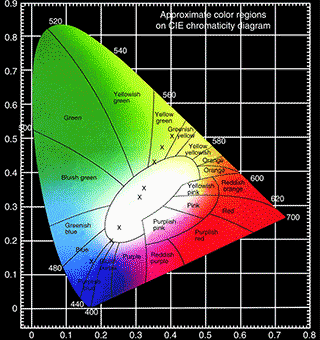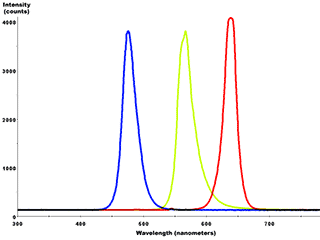Lessons from professionals: Full-color LED screens
In our article Unseen “driving” force: IC drivers for LED screens, we wrote about the Chinese company CCDL that not only designs and develops IC drivers (chips) but also produces full-color LED screens. Let us take a look at the developments in the area of electronic light displays/signs on basis of LED technology, conducted by company CCDL (Central China Display Laboratories, LTD).
CCDL’s displays use ultra bright red, green and dark-blue LEDs together with specially developed integrated circuits LSIS, and highly complex VLSIS integrated circuits, which ensure the most precise transfer of the colors. Such screen's range of brightness is from 1500 to 12000 nits with 16.7 millions of color. Life of LED CCDL - is 100 000 hours, after which they require complete replacement of light-carrier surface.
The diagram shows how to reach the ultra-vision, which creates bright natural color, using “true green” LED that has high brightness and broadband of colored tones.
 |
 |
“True green” - is green color with the wavelength less than 525 nm in the comparison with “yellow green”, which has the wavelength more than 565 nm. Combination of red, “true green” and dark-blue gives the possibility to transfer precise colors and their tints.
CCDL uses the latest achievements in LED technology for the design of electronic displays, which can show messages, video, complex drawing and animated cartoon. For example, such technologies are:
- use of computerized system, which ensures uniform color intensity of the LED module, within the limits of color display;
- use of VLSIS diagrams of its own development, which increase lifetimes of the LED;
- improvement of the cooling systems for the LED displays, which are installed in different climatic conditions.
In six years of experiments and development, CCDL created more than eight different types of LSIS and VLSIS diagrams, each of which was intended for fulfilling special functions. Thus, for instance, 304-pin IC chip, in which the high speed parallel method of treating the video signal is used, makes it possible to process 24 bits RGB signal, which provides 64 pixels or 192 points of luminosity. This permits the current increase to 24 mA with the work of the display; alternating and return currents, which influence on colors and their brightness disagreement, are eliminated.
Also this IC chip realizes special functions, which depending on the type of the display ensures the possibility of 3D video, video with the transitional regeneration, work with high-speed video cameras.
Such SIS diagrams for LED screens eliminate the following restrictions:
- ability to show 15-24 frames per second;
- lack of brightness control capability, and even if they are ensured, the colors cannot be balanced as they must be during the evening time.
LED lifetime
The early versions of LEDs, which appeared approximately 20 years ago, were expensive and dim, but their compact size, very low energy consumption, the ability to resist vibration and long lasting duration period made them extremely popular as the indicators on all types of equipment. An increase in the intensity of light and the reduction of cost led to the expansion of LED applications. With the appearance of dark-blue LED, it became possible to create the full-color LED display.
Nichia Company was the central one in these studies and has a lot of experience and possibilities of conducting different types of tests on the quality of light-emitting diodes (LED). Experimenting with the dark-blue LED, Nichia proved that current reduction increases lifetime of the LED. In other words, sending current of 10 mA on dark-blue LED increases its “life” by half and is becoming equal to green LED. Therefore, controlling the current, which passes through the LED, it is possible to estimate LED's average “life” duration, around 200 000 hours.
Current, that passes through LED - is only one of several factors, which determine lifetime of the LED. Although, the electronic light display can work 24 hours a day, individual pixels, constantly switch “On” and “Off”, thus increasing the average life duration of the LED. Since, light displays can be used in the night less brightly than during the day, less current is passed through the LED, which leads to an increase of LED’s lifetime as well. In each pixel there are several LEDs and not each color completely uses all the LEDs. This also increases the life duration of the LED in the display.
Sometimes, screen's temperature exceeds 25°C, this decrease the lifetime of the LED. Air and dust leave mud on LED’s surface - this decreases their brightness. In contrast to air the dust, which is present in the contaminated display, has considerably larger negative effect on the LED, since it leads to the oxidation, the rust on the electronic and metalized parts of the screen, that decrease lifetime of the LEDs. Being based on these factors the average lifetime of the LED, according to CCDL estimation is equal to one half of 200 000 hours and in average is 100 000 hours of continuous operation.
LED display cooling system
Since LEDs are semiconductors, they are sensitive to the high temperature. The current strength for each LED must be reduced at high temperatures in order to avoid its failure. With the current reduction, supplied to LED in connection with an increase in temperature, occurs the disagreement of brightness and color of the display. Nichia's LED sustains maximum current of 30 mA at 25°C. If temperature increases, then the current, supplied to the LED must be regulated, which decrease LED’s brightness. And vice versa, if ambient temperature is lower (but not lower than -10°C), then LED’s brightness will be growing. Thus, the inside temperature of the LED display must be maintained at 25°C, in order to ensure the greatest brightness and to maximize lifetime of the LED.
It is necessary to consider that ambient temperature of the LED does not correspond to the temperature of ambient air that is out of the LED display. All types of electronic displays are made with the black external surfaces in order to ensure maximum high-contrast imaging. This black background absorbs a larger quantity of heat, than the surfaces of other colors, and therefore, if the temperature of ambient air is between 20°C and 25°C, then temperature inside the display can be twice higher. For the sensitive to the high temperature LEDs it is required that the LED display cooling system would guarantee the proper temperature inside the panel, which would maximize brightness and lifetime of the LED. Thus, for instance, brightness of the CCDL display after five years of operation does not exceed even 50% from the initial brightness.
Let us present below the approximate composition of complete set and basic characteristics of one of the versions of electronic displays based on LED technology.
Specification of 28 m2 LED full color video display:
- Size: 4 m (H) x 7 m (W) = 28 m2 (approximately 13 feet x 23 feet = 302 sq. ft.)
- Pixel: 8R+2G+2B high brightness of the highest quality LEDs in one 28x28 mm pixel
- Pitch: 31.25 mm
- Resoultion: 128x224 pixels
- Density Pixel: 1024 pixels/m2
- Number of Pixels: 28 672
- Gradation: 256 levels for each color
- Colorfulness: 16.7 million color
- Peak brightness: 6 000 nit
- Video System: NTSC/PAL
- Electricity consumption: 12 kW, 23 kW peak
- Refresh: 60 Hz (30 frames per second)
Structure of the LED display
Display consists of the upper and lower screens, both of which include:
- broadcasting control system;
- control system, electric power supply control system, conditioning system and sonic tracking control system;
- supervisory control.
As a whole, light-emitting diode electronic displays ensure the greatest resolution per area unit. Large capital R&D investments have positively affected the company’s final product: mobile electronic screens. CCDL screens are now working in many parts of the world, and their reliability is determined by the correct approach to driving LEDs.





